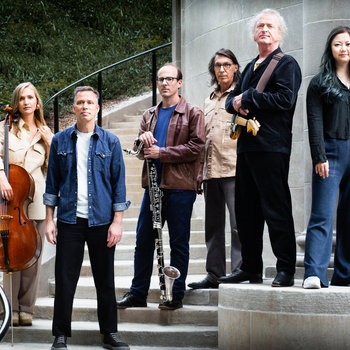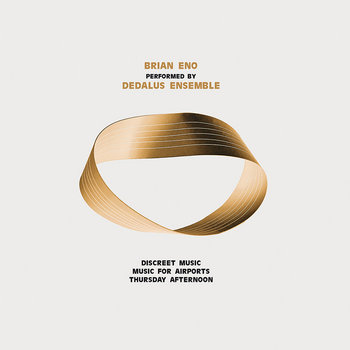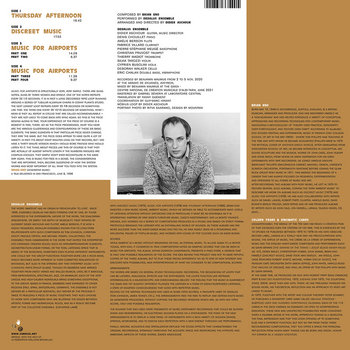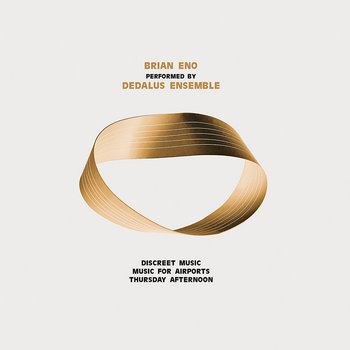
Music for Airports is one of the most important recordings of the 20th century. Released by Brian Eno in 1978, it introduced the concept and experience of ambient music to a mass audience. Already a popular figure due to his membership in Roxy Music; his collaborations with Robert Fripp, David Bowie, and the German electronic band Cluster; and solo releases Taking Tiger Mountain (By Strategy) and Another Green World, with Music for Airports, Eno took ambient music out of its previously historical, experimental, and accidental niches and established it as clearly defined genre. Over the decades since its release, and especially in the 21st century, ambient music has become one of the most substantial global musical styles, with a massive presence on Bandcamp alone.
Eno gave ambient music its name (the record’s full official title is Ambient 1: Music for Airports) and also codified some of the genre’s essential aesthetic ideas. The fundamental one, as he described in the liner notes, is that the music should “accommodate many levels of attention without enforcing one in particular.” In other words, the music would be part of the ambient sound within the listener’s earshot, which Eno likened to Muzak—at the time much more prominent in the public consciousness as music that was designed to boost consumerism in stores and productivity in offices. This fit the genre retroactively into the history of classical music with its connection to Erik Satie, whose work was described by composer Darius Milhaud as “musical furniture—music to be heard but not listened to.”
Another vital feature of the music was its lack of teleology: It’s not meant to express a lyrical or narrative idea, it’s not meant to guide the listener’s emotions, it doesn’t have a social purpose, and formally it doesn’t have a clear start or finish. Instead, it begins, it exists in space and time, and then it comes to an end—literally, in the way that, working with the technology of the time, there was only so much that could fit on the side of a vinyl LP. Again, Eno was not the first to do this, but was arguably the first to present this to listeners who mostly heard rock and pop music.
That made it controversial at the time. Rolling Stone magazine dismissed it and the Spin Record Guide rated it below average, and Eno himself noted in an interview with Lester Bangs that no wave legend Lydia Lunch didn’t think much of the record. But revisionist 21st century opinion (even in Rolling Stone) deems it both essential and a masterpiece. More important than critical judgment, however, has been how the music has become independent of the album, a self-contained piece in the way of a song or a classical music score, something for other musicians to respond to, rework, and play in their own way. The “Airport” metaphor has deepened and the music has become a means to travel and spread the word to further destinations.
Bang on a Can
Music for Airports (Live)








Compact Disc (CD)




The travels began with Bang on Can composers Michael Gordon, David Lang, and Julia Wolfe. They transcribed the music from Music for Airports and arranged it for the Bang on a Can All-Stars ensemble, presenting it live starting in 1998. All at once, Music for Airports became not just something others could play but a new music repertoire, not just ambient music but a vehicle for human expression.
Psychic Temple
Plays Music for Airports






Vinyl LP, 2 x Vinyl LP




This remarkable album uses Music for Airports as just a first step to explore and bring together many worlds in just three tracks. Led by Chris Schlarb, Psychic Temple takes the first identifiable musical phrase from “1/1”—the first track on the original album—and uses it like a jazz riff, something to bring the band together and improvise around. The Afrobeat flavor of “Music for Bus Stops” still has the same colors and textures of the original. The sound of this album expands history, modeled after Miles Davis’s In a Silent Way, a proto-ambient album produced through a studio practice that was an influence on Eno.
William Basinski
Music for Abandoned Airports: Tegel


From ambient musician William Basinksi’s personal archive comes this extended track. Though Basinski acknowledges Eno as the specific inspiration, that doesn’t capture what makes it so compelling. There’s a palpable feeling of space here, empty corridors that once used to contain footfalls, conversations, and maybe even Music for Airports piped through the PA. Now all that’s left are lingering vibrations embedded in the walls, and it seems Basinski has somehow captured them with a microphone.
Dedalus Ensemble
Performing Brian Eno: Discreet Music/Music for Airports/Thursday Afternoon






Compact Disc (CD), 2 x Vinyl LP




A significant measure of the influence and depth of a piece of music is how many different ways there are to work with it, reshape it, recolor it, renew it. The Dedalus Ensemble is a chamber group, larger than the Bang on a Can All-Stars and with a different instrumentation. They made their own transcription and arrangement of Music for Airports, one that moves the music further away from the sound of the original album into something much closer to classical music. More than a simple change in timbres, there’s a whole new idea about the structure of the music as something no longer ambient but prominent, not about space but how musical ideas can be put together into an organic form. The transcriptions of Eno’s Discreet Music and Thursday Afternoon are also transformative and beautiful.
Bruce Brubaker
Eno Piano






Vinyl LP, Compact Disc (CD)




Bruce Brubaker is a pianist who in the past has moved minimalist music into ambience. Here he goes in the other direction, turning Music for Airports into a minimalist piano work set inside an ambient soundscape that has the spacious resonance of the original. Like other transcriptions, he concentrates on the musical phrases. The intimacy of hearing the piano pedal on “2-1” circles back to the idea of ambient music and Music for Airports specifically as a private listening experience where the individual chooses the level of attention. Brubaker could be right there in the room next to you, delivering Eno’s ideas straight from the source to an audience of one.







